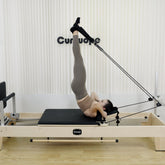Does Pilates speed up your metabolism?
Pilates is a form of exercise that focuses on strength, flexibility, and controlled movements. It was developed in the early 20th century by Joseph Pilates and has gained popularity in recent years as a low-impact form of exercise that can improve overall fitness and well-being. One common question people have about Pilates is whether it can speed up their metabolism. In this article, we will explore what metabolism is, how Pilates affects it, and whether it can be a useful tool for weight loss.

What is Metabolism?
Metabolism refers to the chemical processes that occur in your body to maintain life. It is the sum of all the chemical reactions that occur in your cells to convert the food you eat into energy. Your body uses this energy to perform various functions such as breathing, circulating blood, and maintaining body temperature. Metabolism can be divided into two categories: catabolism and anabolism. Catabolism refers to the breakdown of molecules to release energy, while anabolism refers to the synthesis of molecules to build tissue.
Your metabolic rate is the amount of energy your body uses to perform these functions. It is influenced by many factors, including your age, gender, body size, body composition, genetics, and physical activity level. The higher your metabolic rate, the more energy your body uses, which can help you maintain a healthy weight.
How Does Pilates Affect Metabolism?
Pilates is a low-impact form of exercise that can improve overall fitness and well-being. It focuses on controlled movements that engage the core muscles, improve flexibility, and increase strength. Pilates can help you develop a stronger core, improve your posture, and reduce the risk of injury. However, whether Pilates can speed up your metabolism is a topic of debate.
Some studies suggest that Pilates can increase metabolic rate and burn more calories. One study published in the Journal of Bodywork and Movement Therapies found that women who practiced Pilates for 12 weeks experienced a significant increase in their resting metabolic rate. Another study published in the Journal of Sports Science and Medicine found that Pilates practitioners burned more calories during and after exercise compared to a control group.
However, other studies have found that Pilates may not have a significant effect on metabolism. One study published in the Journal of Strength and Conditioning Research found that Pilates did not increase resting metabolic rate or energy expenditure in women with obesity. Another study published in the Journal of Sports Medicine and Physical Fitness found that Pilates did not significantly affect energy expenditure in women with sedentary lifestyles.
These conflicting results suggest that the effect of Pilates on metabolism may depend on various factors, such as the intensity and duration of the exercise, the fitness level of the practitioner, and their body composition. In general, Pilates is considered a moderate-intensity form of exercise, which may not burn as many calories as high-intensity activities like running or weightlifting.
Can Pilates Help with Weight Loss?
Weight loss occurs when you consume fewer calories than your body uses, creating a calorie deficit. To lose weight, you need to create a calorie deficit of around 500 to 1000 calories per day, which can be achieved through a combination of diet and exercise. Pilates can be a useful tool for weight loss if it is combined with a healthy diet and other forms of exercise.
Pilates can help you build muscle, which can increase your metabolic rate and burn more calories at rest. However, to see significant weight loss results, you need to combine Pilates with other forms of exercise that burn more calories, such as cardio and strength training. You also need to ensure that you are consuming fewer calories than your body uses.
In conclusion, Pilates can be a useful form of exercise that can improve overall fitness.





